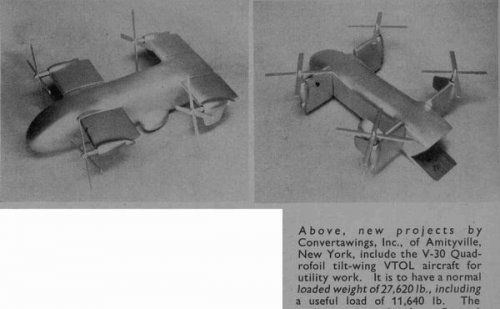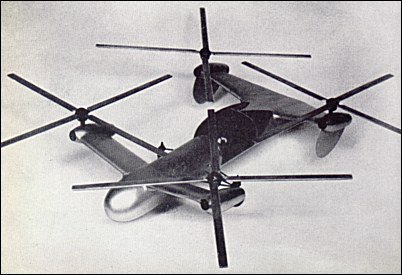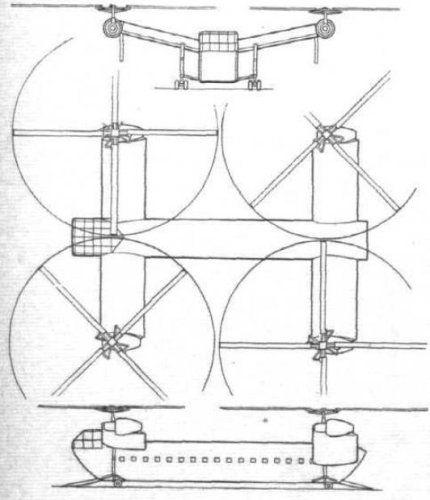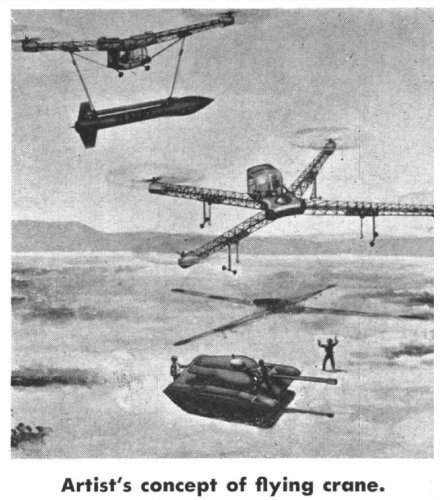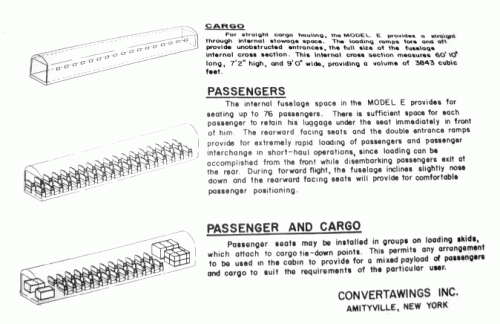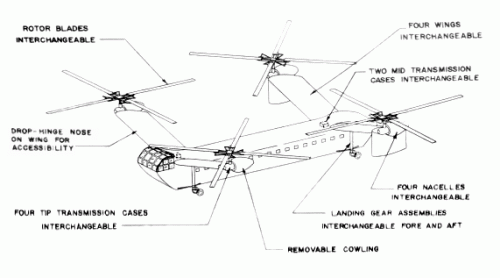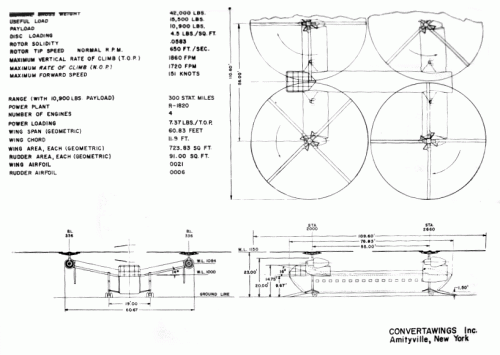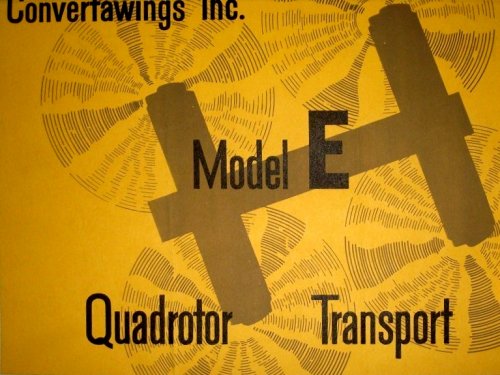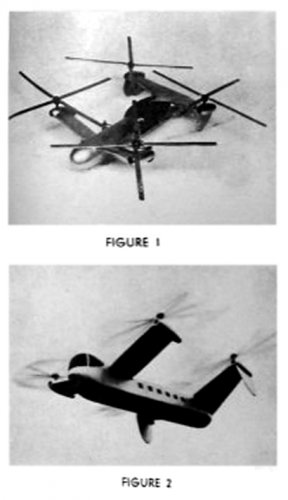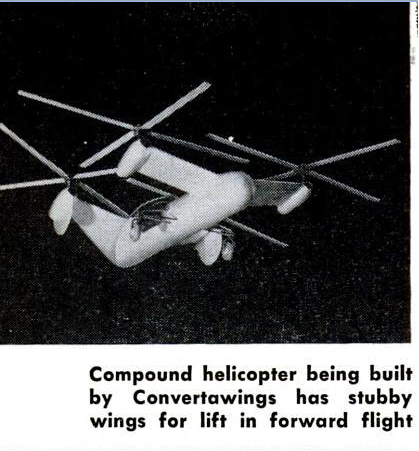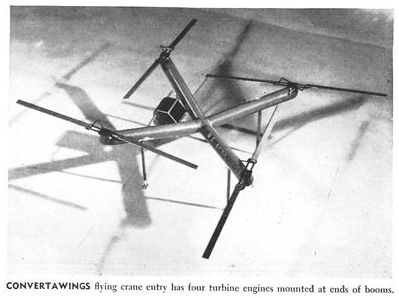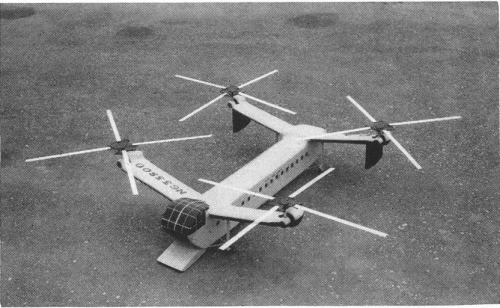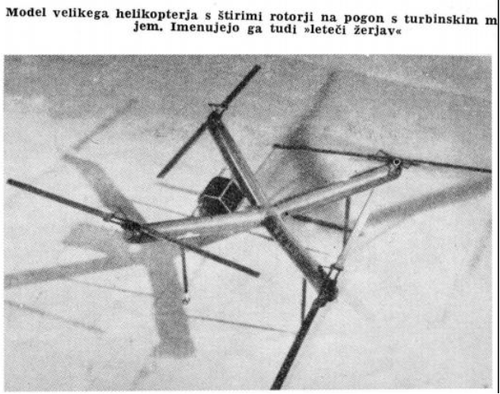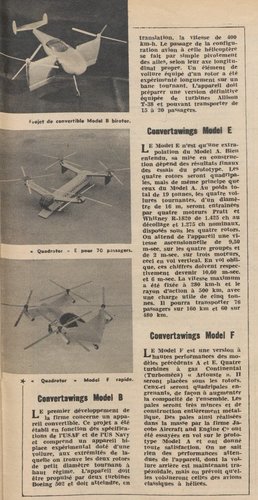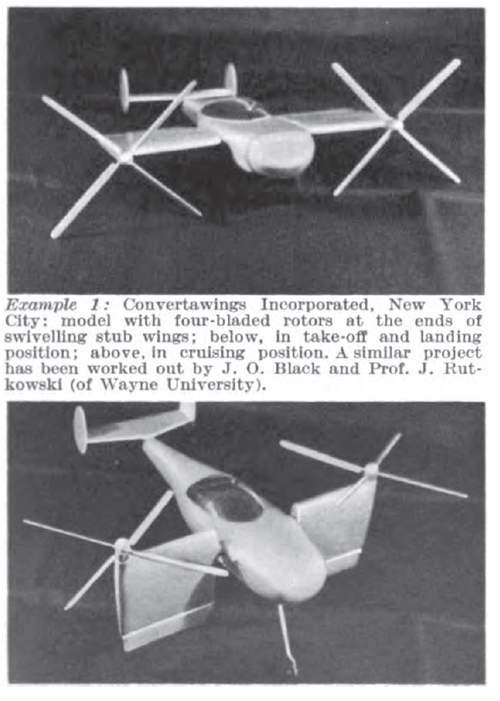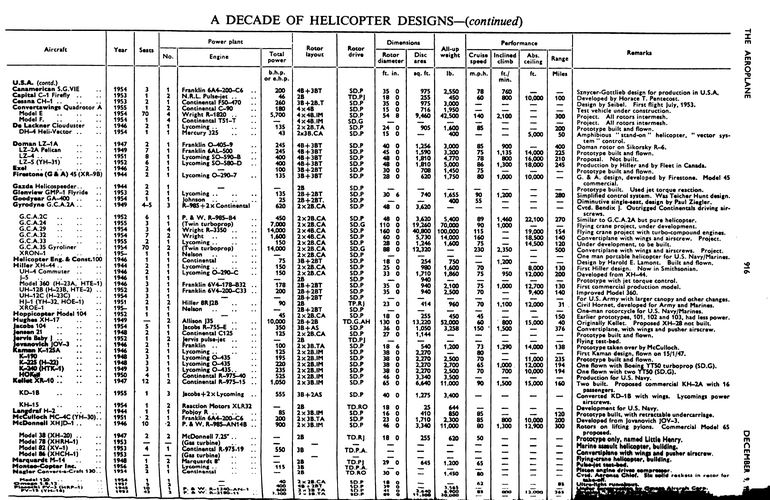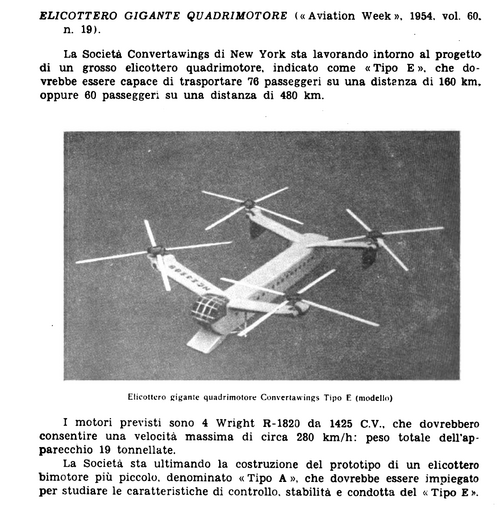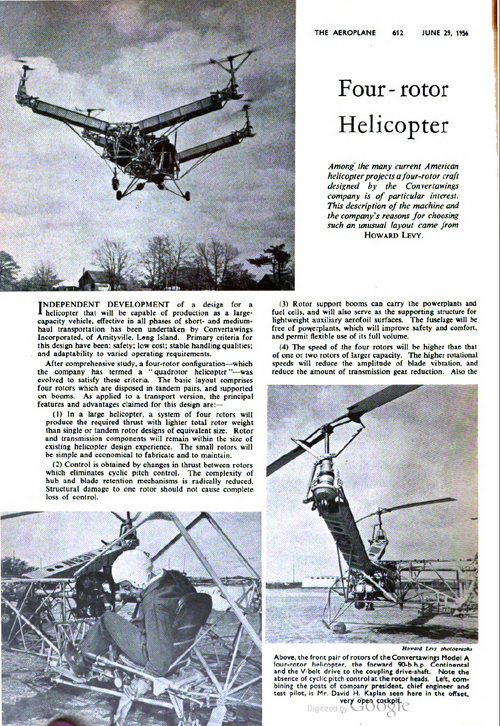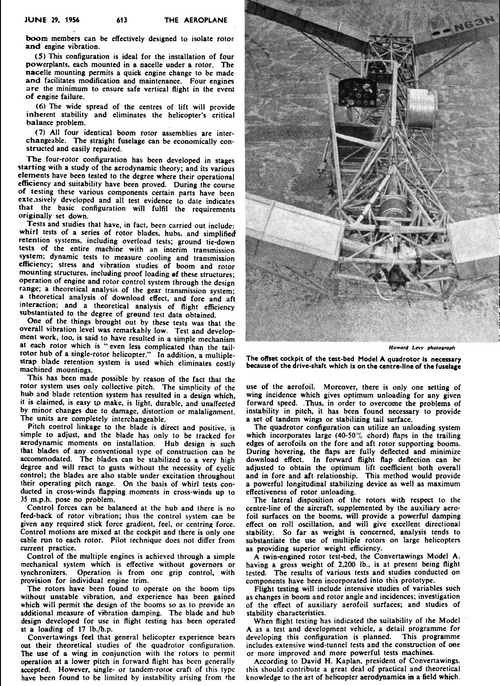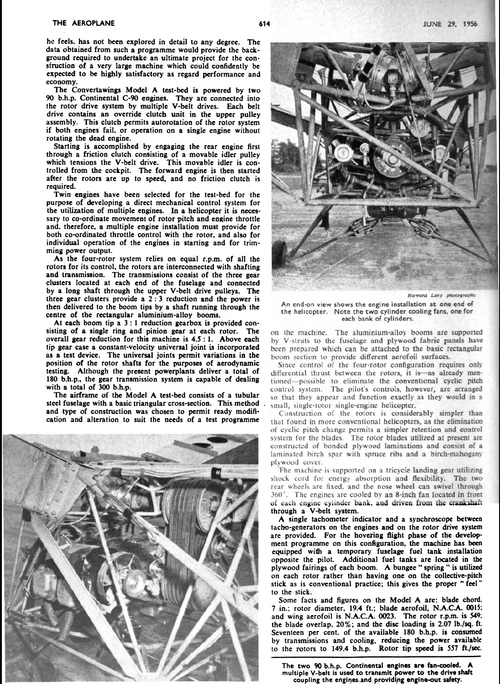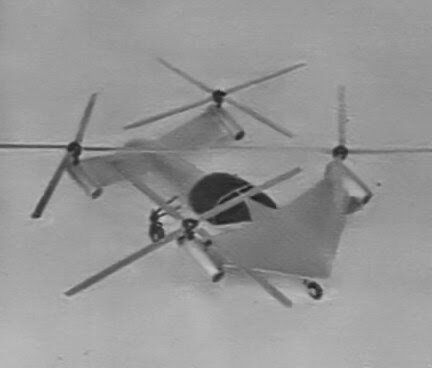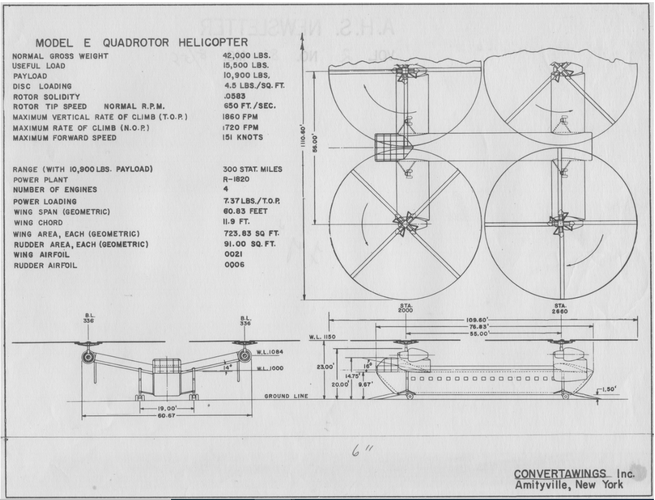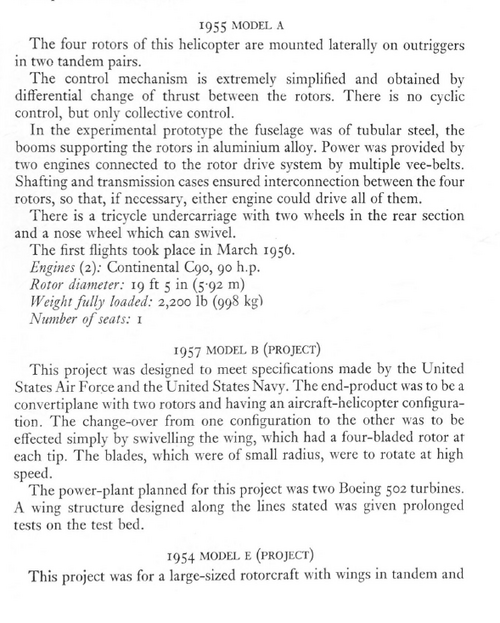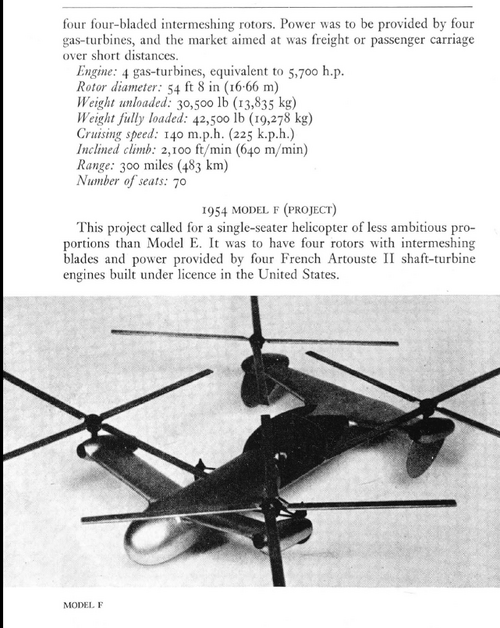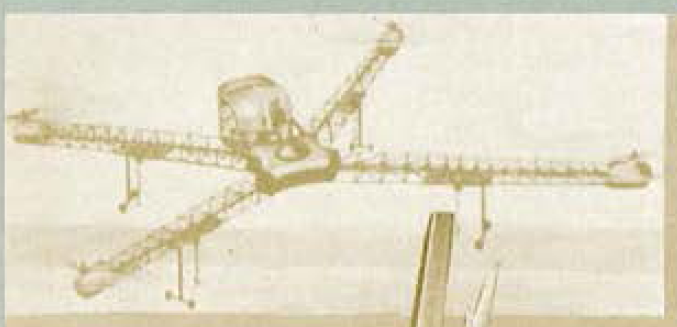You are using an out of date browser. It may not display this or other websites correctly.
You should upgrade or use an alternative browser.
You should upgrade or use an alternative browser.
Convertawings « Quadrotor » designs (Models A to F)
- Thread starter luedo34
- Start date
- Joined
- 11 March 2006
- Messages
- 8,625
- Reaction score
- 3,807
- Joined
- 26 May 2006
- Messages
- 34,919
- Reaction score
- 15,793
Hi,
some info about the Model B and Model F;
This project has been designed to meet specifications by the United States
Air Force and the United States Navy. The end-product is to be a convertiplane
with two rotors and having an aircraft-helicopter configuration. The change-over
from one configuration to the other will be effected simply by swivelling the wing,
which has a four-bladed rotor at each tip. The blades, which are of small radius,
will rotate at high speed. The power plant planned for this project is two Boeing
502 turbines. A wing structure designed along the lines stated has already been
given prolonged tests on the test bed.
http://www.aviastar.org/helicopters_eng/convertawings_f.php
some info about the Model B and Model F;
This project has been designed to meet specifications by the United States
Air Force and the United States Navy. The end-product is to be a convertiplane
with two rotors and having an aircraft-helicopter configuration. The change-over
from one configuration to the other will be effected simply by swivelling the wing,
which has a four-bladed rotor at each tip. The blades, which are of small radius,
will rotate at high speed. The power plant planned for this project is two Boeing
502 turbines. A wing structure designed along the lines stated has already been
given prolonged tests on the test bed.
http://www.aviastar.org/helicopters_eng/convertawings_f.php
Attachments
- Joined
- 25 June 2009
- Messages
- 14,754
- Reaction score
- 6,156
- Joined
- 26 May 2006
- Messages
- 34,919
- Reaction score
- 15,793
hesham said:Hi,
some info about the Model B and Model F;
This project has been designed to meet specifications by the United States
Air Force and the United States Navy. The end-product is to be a convertiplane
with two rotors and having an aircraft-helicopter configuration. The change-over
from one configuration to the other will be effected simply by swivelling the wing,
which has a four-bladed rotor at each tip. The blades, which are of small radius,
will rotate at high speed. The power plant planned for this project is two Boeing
502 turbines. A wing structure designed along the lines stated has already been
given prolonged tests on the test bed.
http://www.aviastar.org/helicopters_eng/convertawings_f.php
Isn't this the competition for XV-1,XV-2 and XV-3 convertiplane ?,
and if it is,that means the Model-B was involved in it.
- Joined
- 25 June 2009
- Messages
- 14,754
- Reaction score
- 6,156
Very unlikely. The XV- competition took place circa 1952-53. The XV- designations were used from 1955. If the Convertawings Model A was a 1956 design, the Model B (which was a much more advanced derivative of the same concept) was a later design, so it could not be part of that same design competition.
When I visited the Long Island Museum back in 1993, I remember that the Convertawings Model A Quadrotor prototype had a sign that said the Army had purchased the prototype and given Convertawings a contract in 1959, I think. I have often wondered if this might be related to the undocumented H-44 designation... Anyway, it seems that the Quadrotor had no direct equivalent in other companies and was most likely an unsollicited initiative.
When I visited the Long Island Museum back in 1993, I remember that the Convertawings Model A Quadrotor prototype had a sign that said the Army had purchased the prototype and given Convertawings a contract in 1959, I think. I have often wondered if this might be related to the undocumented H-44 designation... Anyway, it seems that the Quadrotor had no direct equivalent in other companies and was most likely an unsollicited initiative.
- Joined
- 25 June 2009
- Messages
- 14,754
- Reaction score
- 6,156
- Joined
- 25 June 2009
- Messages
- 14,754
- Reaction score
- 6,156
Convertawings Inc. Model E Quadrotor Transport
A transport helicopter for cargo, utility, passengers up to 14,000 lb. payload!
(from the original company brochure)
A transport helicopter for cargo, utility, passengers up to 14,000 lb. payload!
(from the original company brochure)
Attachments
- Joined
- 25 June 2009
- Messages
- 14,754
- Reaction score
- 6,156
There are two versions of the Convertawings configuration. The small machine with intermeshed rotors (see Fig.1) is intended as a high-performance, compact military machine powered by four Continental Artouste II shaft turbines. This model permits economies in rotor design and should provide improved handling qualities.
The small high-speed rotors will extend the available speed range of the helicopter by reducing the high-speed vibration and control problems of conventional rotors. The thin blade sections possible will permit the higher forward flight tip speeds sought by the helicopter industry.
The large machine (Fig.2) is a commercial version intended to have moderate performance but excellent maintenance characteristics. The reduced blade size and gear reduction involved will permit economical mass production of the four identical rotor assemblies. In combination with the lifting booms and empennage, the basic stability advantage of the configuration should provide marked improvement over conventional helicopters and permit development of safe all-weather operating techniques.
(from AMERICAN HELICOPTER, October 1953)
Attachments
- Joined
- 26 May 2006
- Messages
- 34,919
- Reaction score
- 15,793
- Joined
- 26 May 2006
- Messages
- 34,919
- Reaction score
- 15,793
- Joined
- 25 June 2009
- Messages
- 14,754
- Reaction score
- 6,156
hesham said:Hi,
here is a Model for Convertawings
That's Model B.
- Joined
- 26 May 2006
- Messages
- 34,919
- Reaction score
- 15,793
From Krila 2/1957,what was Model designation for this beast ?.
Attachments
- Joined
- 26 May 2006
- Messages
- 34,919
- Reaction score
- 15,793
From Aviation magazine 1957,and as dear Maveric sent before,the whole article.
Attachments
-
![Aviation_magazine___président-directeur_général_[...]_bpt6k53234136_21.jpeg](/data/attachments/165/165237-1abf94d05d99869cf3423b7ab89c539c.jpg) Aviation_magazine___président-directeur_général_[...]_bpt6k53234136_21.jpeg1.9 MB · Views: 103
Aviation_magazine___président-directeur_général_[...]_bpt6k53234136_21.jpeg1.9 MB · Views: 103 -
![Aviation_magazine___président-directeur_général_[...]_bpt6k53234136_22.jpeg](/data/attachments/165/165238-f6af34c093be0e685afacbcd37314f83.jpg) Aviation_magazine___président-directeur_général_[...]_bpt6k53234136_22.jpeg1.6 MB · Views: 93
Aviation_magazine___président-directeur_général_[...]_bpt6k53234136_22.jpeg1.6 MB · Views: 93 -
![Aviation_magazine___président-directeur_général_[...]_bpt6k53234136_23.jpeg](/data/attachments/165/165243-4dc6353b9eeda9d39ab968b7f285cdaf.jpg) Aviation_magazine___président-directeur_général_[...]_bpt6k53234136_23.jpeg1.5 MB · Views: 86
Aviation_magazine___président-directeur_général_[...]_bpt6k53234136_23.jpeg1.5 MB · Views: 86 -
![Aviation_magazine___président-directeur_général_[...]_bpt6k53234136_34.jpeg](/data/attachments/165/165244-aba1f08b15a4692fe9ddefbb1c2106d4.jpg) Aviation_magazine___président-directeur_général_[...]_bpt6k53234136_34.jpeg1.6 MB · Views: 112
Aviation_magazine___président-directeur_général_[...]_bpt6k53234136_34.jpeg1.6 MB · Views: 112
- Joined
- 26 May 2006
- Messages
- 34,919
- Reaction score
- 15,793
From Krila 2/1957,what was Model designation for this beast ?.
I think that was Model-C,an Observation and Liaison Quadrotor of March 1952 .
- Joined
- 26 May 2006
- Messages
- 34,919
- Reaction score
- 15,793
Model-F,
The Model F was a high-performance version of the previous Models A and E. Four Continental (Turbomeca) "Artouste" gas turbines were placed under the rotors.
These were four-bladed meshing, so as to increase the compactness of the whole. The blades were very thin and of all-metal construction. Blades thus produced in mass by the firm Jacobs Aircraft and Engine C° were tested in flight on the Model A prototype and gave complete satisfaction.
Nothing is known about the expected performance of the aircraft, whose rear wing was now trapezoidal, but it was expected that they would be close to those of conventional propeller aircraft.

 maquettes-missiles.blogspot.com
maquettes-missiles.blogspot.com
The Model F was a high-performance version of the previous Models A and E. Four Continental (Turbomeca) "Artouste" gas turbines were placed under the rotors.
These were four-bladed meshing, so as to increase the compactness of the whole. The blades were very thin and of all-metal construction. Blades thus produced in mass by the firm Jacobs Aircraft and Engine C° were tested in flight on the Model A prototype and gave complete satisfaction.
Nothing is known about the expected performance of the aircraft, whose rear wing was now trapezoidal, but it was expected that they would be close to those of conventional propeller aircraft.

Le Convertawings " Quadrotor".
Attachments
- Joined
- 26 May 2006
- Messages
- 34,919
- Reaction score
- 15,793
Hi,
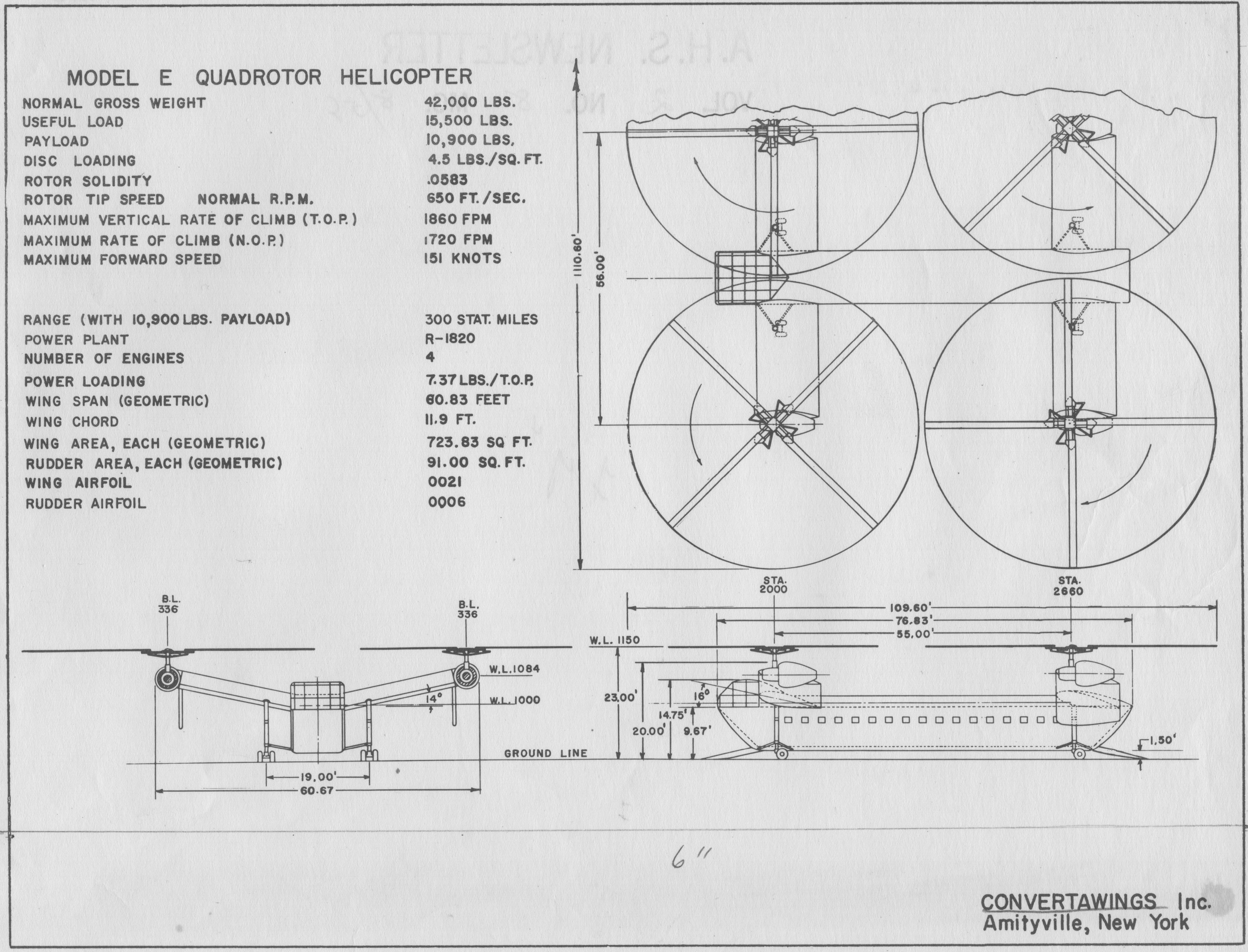
 gallery.vtol.org
gallery.vtol.org

Convertawings Model E Quadrotor helicopter
Convertawings Model E Quadrotor helicopter. Figure 4, from Vertiflite (AHS Newsletter) Aug 1956.
Attachments
Similar threads
-
US Navy 1951 Observation / Liaison helicopter competition
- Started by Stargazer
- Replies: 16
-
-
-
F-101 weapons / fuel pods : Model 96 / XW-5
- Started by Sferrin
- Replies: 57
-

